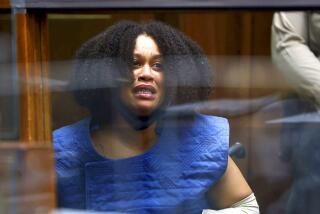Beyond physical trauma
- Share via
AN avid cyclist, Susan Dopart was on her usual early morning ride from her home in Santa Monica to Marina del Rey and back in January 2003 when she was hit by a car. Witnesses say she flipped over the car before hitting the pavement, unconscious.
“I really should have died in this accident, according to all the doctors who saw me,” says Dopart, 42, a registered dietitian and exercise physiologist. Instead, the collision shattered her left leg but, surprisingly, she suffered no internal injuries.
She underwent surgery on her tibia (the shinbone), and her physical healing began. But she had trouble sleeping. She was anxious. She had little appetite. And she was afraid of the open road.
Despite the symptoms, and the difficulty processing how her life had been turned upside down in seconds, even she was surprised at her diagnosis -- a month after the accident -- of post-traumatic stress disorder.
“I didn’t think of myself as having PTSD,” she says. “I just thought of myself as someone who was in a car accident and now was having horrible anxiety attacks.”
Like Dopart, people who experience post-traumatic stress symptoms often dismiss them as normal reactions to tragic events, and they try to cope on their own, mental health experts say. But although it is normal to be temporarily shaken after a traumatic event, symptoms such as anxiety, intrusive thoughts and depression that last beyond a month may indicate a disorder.
As many as 8% of Americans will develop PTSD at some point in their lives, and women are twice as likely to have it as men, according to the National Center for PTSD. (Women are more likely to be victims of domestic violence, rape or other abuse, the American Psychological Assn. says.)
And the sooner the patient gets help, the better. PTSD becomes increasingly debilitating -- and difficult to treat -- the longer it goes undiagnosed. Dopart’s difficulties became apparent on the way home from the hospital. Although she was happy to be leaving, the drive home terrified her. She was afraid to be in a car, and was thoroughly shaken by the time she arrived.
Her extreme anxiety continued in the following days. Because the accident happened in the morning, that time of the day was a particular ordeal. “I had to take an Ativan [an anti-anxiety medication] just to eat breakfast,” she says. Even then, she barely ate much in the early weeks.
Nights were tough too. She would get anxious just before bedtime. Usually a side-sleeper, she had to rest on her back with her leg propped up for a couple of months so it would heal properly; the pain from her injury and subsequent surgery was so bad it would wake her several times during the night. When she did sleep, she would have vivid dreams of ambulances and accidents.
“I went from being a really good sleeper to having horrible sleeping issues,” she says.
*
Fears and anxiety
And though Dopart met with her psychotherapist, Barbara Monroe of Northridge, every week or so, her anxiety was fueled by her fears. She worried she wouldn’t be able to resume her active lifestyle or, as a single woman unable to work, make the mortgage payments on her new house.
She also was afraid that someone might accidentally hit her injured leg and prevent it from healing properly. “I was always protecting that leg,” she says. Even something as routine as going out to dinner prompted her to be super-vigilant about anyone brushing against her. “My fears went up a thousand percent,” she says.
While recovering from the accident, Dopart had multiple physical therapy and other health appointments every week. Because her mother drove her to them, slowly, Dopart managed to keep her road fears in check.
When she finally got behind the wheel seven months after the accident, her anxieties surged. So she used her car as little as possible, driving only to her office a mile away or to the grocery store, and she avoided the freeway for the first few months.
Reminders of the accident caused her fears to increase. “One day I was driving and I saw an ambulance and I had to pull over,” she says.
Eventually, she worked up to driving on the freeway but tried to avoid it at night. “I would see all the lights coming at me and I would get very panicky,” she says.
Monroe says Dopart probably had a smoother recovery than many people experience after a traumatic event because she sought immediate help: Dopart and Monroe began talking about the accident within a week of it happening.
Although most people with PTSD can get their lives back with prompt and proper treatment, some will never completely recover. Some trauma victims may even find themselves unable to work or leave their homes for months, if not longer.
In the year after Dopart’s accident, she and Monroe spoke every week or two -- conversations during which Monroe reassured her that her feelings were normal.
Monroe taught Dopart to control her fear by using imagery to create a safe place in her mind, and eventually to imagine driving to places she enjoyed, such as the Getty Center or to Santa Barbara. Dopart also learned to use deep breathing exercises and muscle relaxation to calm her fears.
Once she was walking again -- five months after the accident -- Dopart began weekly and then biweekly sessions of craniosacral therapy, a hands-on approach that involves gentle manipulation of the head and back.
“It really helped a lot with my anxiety and my driving,” says Dopart, who continued the therapy for about a year and a half.
Less than a year ago, she started six months of Rolfing, another holistic approach that manipulates the soft connective tissues of the body to help release stress. Dopart says sessions every two to three weeks helped to ease her anxiety and the tension in her body.
Keeping a journal also helped her deal with the trauma. “Instead of it being in my head, it was now out on paper,” she says.
Today, Dopart is coping better on her own. The recovery process has been slow, and it’s only recently that she feels almost like her former self.
Still, she’s forever changed. The world just isn’t as safe as it once was.
“In general, I think I have a lot more anxiety than I used to,” Dopart says. “Before, I don’t think I knew what anxiety was.”
The anniversary date of her accident, Jan. 14, has been tough, a day when Dopart has a lot of anxiety and needs Ativan to get through it. But this year was better. “This last anniversary was fine,” she says. “I thought about it and it was OK.”
But she’s not the relaxed driver she was before the accident. “I still have a lot of driving issues,” she says. “I think someone’s going to hit me. When things come at me from my peripheral vision, it freaks me out. I have to constantly work at calming myself down. And I really have to talk myself into driving on the freeway.”
She has persistent sleep troubles too, often waking up in the middle of the night. “I’ve never gone back to being a good sleeper like I was,” she says.
Dopart still undergoes physical therapy every two weeks, and works out at the gym five or six days a week to stay in shape and keep her injured leg strong.
One big positive did emerge from the tragedy. Had it not been for the accident, Dopart says, she wouldn’t have met her husband. She used to hate gyms, preferring to exercise outdoors, but after the accident she joined a gym and last year met her husband there.
As for bike riding, spinning class is as far as she’ll go.
“I would never bike on the road again,” she says. “It’s not worth my life.”
*
(BEGIN TEXT OF INFOBOX)
Where to seek support and information
Post-traumatic stress disorder is typically associated with military combat or natural disasters such as Hurricane Katrina or the Asian tsunami.
But many traumatic experiences, including being in or witnessing a traffic accident, being physically or sexually assaulted, or seeing your house burn or fearing it could slip down a hillside could trigger the condition.
Symptoms may include flashbacks, anxiety, intense fear, nightmares, avoidance of trauma reminders, irritability, depression, difficulty concentrating and emotional numbness.
These groups offer more information:
* National Center for PTSD: The center, part of the Department of Veterans Affairs, supports research and education. www.ncptsd.va.gov.
* Anxiety Disorders Assn. of America: This nonprofit organization offers information, support and help to people seeking treatment. www.adaa.org.
* American Psychiatric Assn.: This organization of physicians provides information and help locating a psychiatrist, plus links to other organizations and agencies. www.psych.org.
* American Psychological Assn.: This professional organization representing psychologists offers information and help finding a therapist. www.apa.org.


